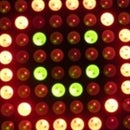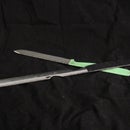Introduction: 3D Scan and Duplicate Yourself (or Anything!)
Using an inexpensive XBOX Kinect (~$100) and a free piece of software (windows only, sorry), you can easily and quickly capture 3d models of people, and then send them to your 3d printer to make little statues!
Submitted by the awesome hackerspace Ace Monster Toys from Oakland, CA for the Instructables Sponsorship Program
Submitted by the awesome hackerspace Ace Monster Toys from Oakland, CA for the Instructables Sponsorship Program
Step 1: Requirements
Things you need:
HARDWARE:
1. XBOX Kinect (Also works with Kinect for Windows, or the Asus/Primesense XtionPRO Live)
2. A 3D Printer (Like an Ultimaker, Makerbot, Solidoodle, etc)
3. A PC running Windows (There are other softwares for other platforms, but the one I use is easy but unfortunately win-only)
SOFTWARE:
1. Kinect Drivers
2. Skanect software (these are both downloadable on the same page)
HARDWARE:
1. XBOX Kinect (Also works with Kinect for Windows, or the Asus/Primesense XtionPRO Live)
2. A 3D Printer (Like an Ultimaker, Makerbot, Solidoodle, etc)
3. A PC running Windows (There are other softwares for other platforms, but the one I use is easy but unfortunately win-only)
SOFTWARE:
1. Kinect Drivers
2. Skanect software (these are both downloadable on the same page)
Step 2: Setting Up
1. Download the software from Skanect's Website
2. Install the Kinect drivers for your particular model
3. Install Skanect
4. Plug in your Kinect
5. Sit in a nice swivel chair
6. Put the kinect on something such that it is about 2-4 feet away from you and slightly above pointing downwards at you (but not too steep of an angle)
2. Install the Kinect drivers for your particular model
3. Install Skanect
4. Plug in your Kinect
5. Sit in a nice swivel chair
6. Put the kinect on something such that it is about 2-4 feet away from you and slightly above pointing downwards at you (but not too steep of an angle)
Step 3: Scanning Yourself
1. Launch the Skanect software
2. Make sure your sensor is detected -- if not, check that the usb and power cable are connected, and that you installed the drivers. Try unplugging it, quitting the software, plugging it back in, then starting Skanect again
3. Click the 'New' button and select "Body". Adjust bounding box if needed -- for just a head, 1 meter cube is usually good, for a whole body you will want 2 to 3 meters (but make sure nothing is too close to you behind you or it will get included)
4. Click the 'Record' tab on top
5. Get your posture straight and get ready to rotate on the chair
6. Click the red button with a black circle (top left) to start recording
7. Slowly swivel around -- it should take about 10-30 seconds for your rotation, perhaps faster if you have a fast PC or slower if you have a slow PC
8. Without moving your upper body (having a friend on hand to do it can help!) click the blue stop button
9. Wait for it to process the data
2. Make sure your sensor is detected -- if not, check that the usb and power cable are connected, and that you installed the drivers. Try unplugging it, quitting the software, plugging it back in, then starting Skanect again
3. Click the 'New' button and select "Body". Adjust bounding box if needed -- for just a head, 1 meter cube is usually good, for a whole body you will want 2 to 3 meters (but make sure nothing is too close to you behind you or it will get included)
4. Click the 'Record' tab on top
5. Get your posture straight and get ready to rotate on the chair
6. Click the red button with a black circle (top left) to start recording
7. Slowly swivel around -- it should take about 10-30 seconds for your rotation, perhaps faster if you have a fast PC or slower if you have a slow PC
8. Without moving your upper body (having a friend on hand to do it can help!) click the blue stop button
9. Wait for it to process the data
Step 4: Processing & Saving the File
[OPTIONAL: Click the 'Reconstruct' tab and reconstruct the model first...in theory this will provide higher quality, but I've never gotten it to work well, and it's super slow]
1. Click the 'Process' tab up top
2. Click the 'Watertight' button on the left
3. Click the 'Run' button under the watertight dialog...wait for it to process...you'll see yourself pop up in color fully solid
4. Click the 'Move & Crop' button on the left
5. Use the 'Ty' slider to chop off the messy bottom parts, so there is a flat surface that will print well
6. Rotate the view around so you can see the bottom, then use that to make sure the bottom is flat -- if you see any red in the middle, it means there's a hole still, so slide it up further
7. If you want / need, you can rotate the model with the Rx/Ry/Rz sliders to make it more straight up if it came out crooked
8. Click the 'Crop to Ground' button
9. Click the 'Share' tab up top
10. Click the 'Export' button on left
11. Type in a file name like 'Dave.STL'
That's it! You now have a 3D model of yourself, which you can load into your 3d printer of choice, or upload to thingiverse and share with the world!
1. Click the 'Process' tab up top
2. Click the 'Watertight' button on the left
3. Click the 'Run' button under the watertight dialog...wait for it to process...you'll see yourself pop up in color fully solid
4. Click the 'Move & Crop' button on the left
5. Use the 'Ty' slider to chop off the messy bottom parts, so there is a flat surface that will print well
6. Rotate the view around so you can see the bottom, then use that to make sure the bottom is flat -- if you see any red in the middle, it means there's a hole still, so slide it up further
7. If you want / need, you can rotate the model with the Rx/Ry/Rz sliders to make it more straight up if it came out crooked
8. Click the 'Crop to Ground' button
9. Click the 'Share' tab up top
10. Click the 'Export' button on left
11. Type in a file name like 'Dave.STL'
That's it! You now have a 3D model of yourself, which you can load into your 3d printer of choice, or upload to thingiverse and share with the world!



